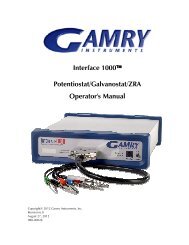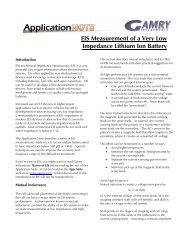Basics of Electrochemical Impedance Spectroscopy - Gamry ...
Basics of Electrochemical Impedance Spectroscopy - Gamry ...
Basics of Electrochemical Impedance Spectroscopy - Gamry ...
Create successful ePaper yourself
Turn your PDF publications into a flip-book with our unique Google optimized e-Paper software.
esistance. The diameter <strong>of</strong> the semicircle is therefore<br />
equal to the polarization resistance (in this case 250 Ω).<br />
Figure 16 is the Bode Plot for the same cell.<br />
mag i<br />
phase i<br />
1000<br />
100<br />
10<br />
0.1 1 10 100 1000 1 10 4 1 10 5<br />
0<br />
50<br />
freq i<br />
100<br />
0.1 1 10 100 1000 1 10 4 1 10 5<br />
freq i<br />
Figure 16. Bode Plot for 1 mm/year Corrosion Rate<br />
Mixed Kinetic and Diffusion Control<br />
First consider a cell where semi-infinite diffusion is the<br />
rate determining step, with a series solution resistance as<br />
the only other cell impedance. (See page 13 to refresh<br />
your memory.)<br />
A Nyquist Plot for this cell is shown in Figure 17. R s was<br />
assumed to be 20 Ω. The Warburg coefficient, σ, is<br />
calculated to be about 150 for the diffusion <strong>of</strong> a species<br />
with a bulk concentration <strong>of</strong> 100 µM and a typical<br />
diffusion coefficient <strong>of</strong> 1.6 x10 -5 cm 2 /s. Notice that the<br />
Warburg impedance appears as a straight line with a<br />
slope <strong>of</strong> 45°.<br />
12<br />
300<br />
240<br />
180<br />
( imag) i<br />
120<br />
60<br />
0<br />
0 60 120 180 240 300<br />
real i<br />
Figure 17. Nyquist Plot for a Warburg <strong>Impedance</strong><br />
The same data is plotted in the Bode format in Figure<br />
18. The phase angle <strong>of</strong> a Warburg impedance is 45˚.<br />
mag i<br />
phase i<br />
1000<br />
100<br />
10<br />
0.1 1 10 100 1000 1 10 4 1 10 5<br />
0<br />
20<br />
40<br />
freq i<br />
60<br />
0.1 1 10 100 1000 1 10 4 1 10 5<br />
freq i<br />
Figure 18. Bode Plot for a Warburg <strong>Impedance</strong><br />
Adding a double layer capacitance and a charge transfer<br />
impedance, we get the equivalent circuit in Figure 19.<br />
This is the Randles Cell; the name is taken from an<br />
article by J.E.B. Randles in the Discussions <strong>of</strong> the




